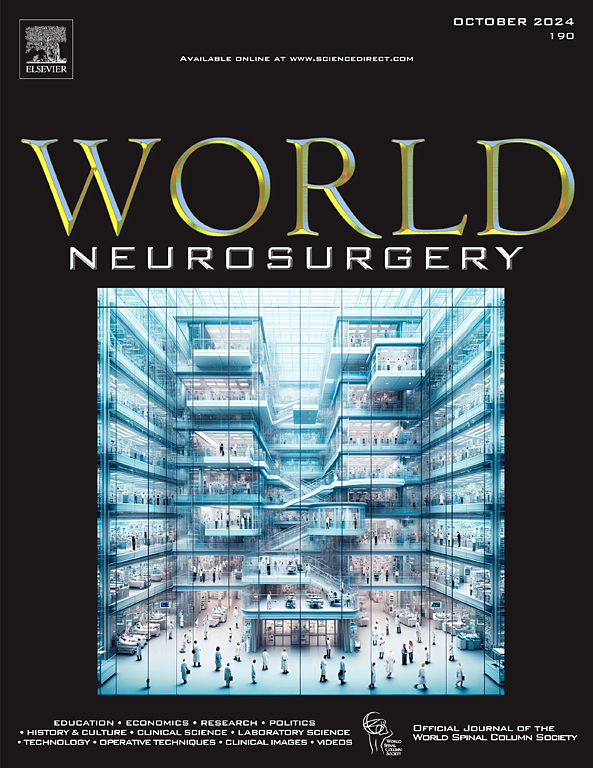短节段内固定治疗骨质疏松性椎体压缩性骨折引起的胸腰椎后凸:一个病例系列。
IF 1.9
4区 医学
Q3 CLINICAL NEUROLOGY
引用次数: 0
摘要
目的评估短节段固定术(SSF)治疗骨质疏松性椎体压缩骨折(OVCFs)引起的胸腰椎后凸的效果:这项回顾性分析纳入了2017年至2022年间在我院接受SSF治疗的28例OVCF引起的胸腰椎后凸患者。测量了站立位和仰卧位之间的 Cobb 角变化,以确定是否需要提前截骨。记录骨矿密度(T-score)和相关血液学骨代谢指标,以评估患者的骨质疏松症状况。手术前后测量了Cobb角和矢状面参数,以确定矫形效果,并使用视觉模拟量表(VAS)和Oswestry残疾指数(ODI)评估功能:结果:共有28名患者成功接受了带或不带高级截骨术的SSF手术,无严重并发症。平均随访时间为 29 ± 3 个月。Cobb角明显下降,从术前的(45° ± 6°)下降到最后一次随访时的(11° ± 3°)(P < 0.05)。与手术前相比,最后一次随访时的 VAS 评分和 ODI 均有明显改善(P < 0.05)。五名患者在术后六个月内出现腰背痛(其中四名患者出现近端交界性脊柱后凸,一名患者出现内固定骨折),其中两名患者接受了第二次手术。在长期随访中,两名患者在再次创伤后出现了 PJK/DJK。其余 21 名患者在最后一次随访时均保持良好的内固定,无螺钉或螺杆断裂、松动或移位:结论:无论是否进行晚期截骨,SSF 都是治疗 OVCF 引起的胸腰椎后凸的有效方法,不仅能取得良好的矫形效果,还能改善患者的生活质量。持续规范的抗骨质疏松治疗对长期康复至关重要。本文章由计算机程序翻译,如有差异,请以英文原文为准。
Short-Segment Fixation for Thoracolumbar Kyphosis Caused by Osteoporotic Vertebral Compression Fractures: A Case Series
Objective
To evaluate short-segment fixation (SSF), with or without advanced osteotomy, for treating thoracolumbar kyphosis caused by osteoporotic vertebral compression fractures (OVCFs).
Methods
This retrospective analysis included 28 patients with thoracolumbar kyphosis caused by OVCFs who underwent SSF at our hospital between 2017 and 2022. The change in the Cobb angle between standing and supine positions was measured to establish whether an advanced osteotomy was necessary. Bone mineral density (T-score) and related hematologic bone metabolism markers were recorded to assess the patient’s osteoporosis status. The Cobb angle and sagittal plane parameters were measured before and after surgery to determine the orthopedic outcomes, and function was assessed using a visual analog scale and the Oswestry Disability Index.
Results
A total of 28 patients successfully underwent SSF with or without advanced osteotomy, with no serious complications. The mean follow-up period was 29 ± 3 months. The Cobb angle decreased significantly, from 45° ± 6° before surgery to 11° ± 3° at the last follow-up (P < 0.05). The visual analog scale scores and Oswestry Disability Index at the last follow-up were significantly improved compared with those before surgery (P < 0.05). Five patients developed low back pain within 6 months of surgery (proximal junctional kyphosis in 4 patients and internal fixation fractures in 1 patient), and 2 of these patients underwent a second surgery. In the long-term follow-up, 2 patients had proximal junctional kyphosis/distal junctional kyphosis after the re-trauma. The 21 remaining patients maintained good internal fixation at the last follow-up, with no broken screws or rods, loosening, or displacement.
Conclusions
SSF, with or without advanced osteotomy, is an effective treatment for thoracolumbar kyphosis caused by OVCFs, achieving good orthopedic outcomes and improving the quality of life of patients. Continuous standardized anti-osteoporosis treatment is essential for long-term recovery.
求助全文
通过发布文献求助,成功后即可免费获取论文全文。
去求助
来源期刊

World neurosurgery
CLINICAL NEUROLOGY-SURGERY
CiteScore
3.90
自引率
15.00%
发文量
1765
审稿时长
47 days
期刊介绍:
World Neurosurgery has an open access mirror journal World Neurosurgery: X, sharing the same aims and scope, editorial team, submission system and rigorous peer review.
The journal''s mission is to:
-To provide a first-class international forum and a 2-way conduit for dialogue that is relevant to neurosurgeons and providers who care for neurosurgery patients. The categories of the exchanged information include clinical and basic science, as well as global information that provide social, political, educational, economic, cultural or societal insights and knowledge that are of significance and relevance to worldwide neurosurgery patient care.
-To act as a primary intellectual catalyst for the stimulation of creativity, the creation of new knowledge, and the enhancement of quality neurosurgical care worldwide.
-To provide a forum for communication that enriches the lives of all neurosurgeons and their colleagues; and, in so doing, enriches the lives of their patients.
Topics to be addressed in World Neurosurgery include: EDUCATION, ECONOMICS, RESEARCH, POLITICS, HISTORY, CULTURE, CLINICAL SCIENCE, LABORATORY SCIENCE, TECHNOLOGY, OPERATIVE TECHNIQUES, CLINICAL IMAGES, VIDEOS
 求助内容:
求助内容: 应助结果提醒方式:
应助结果提醒方式:


